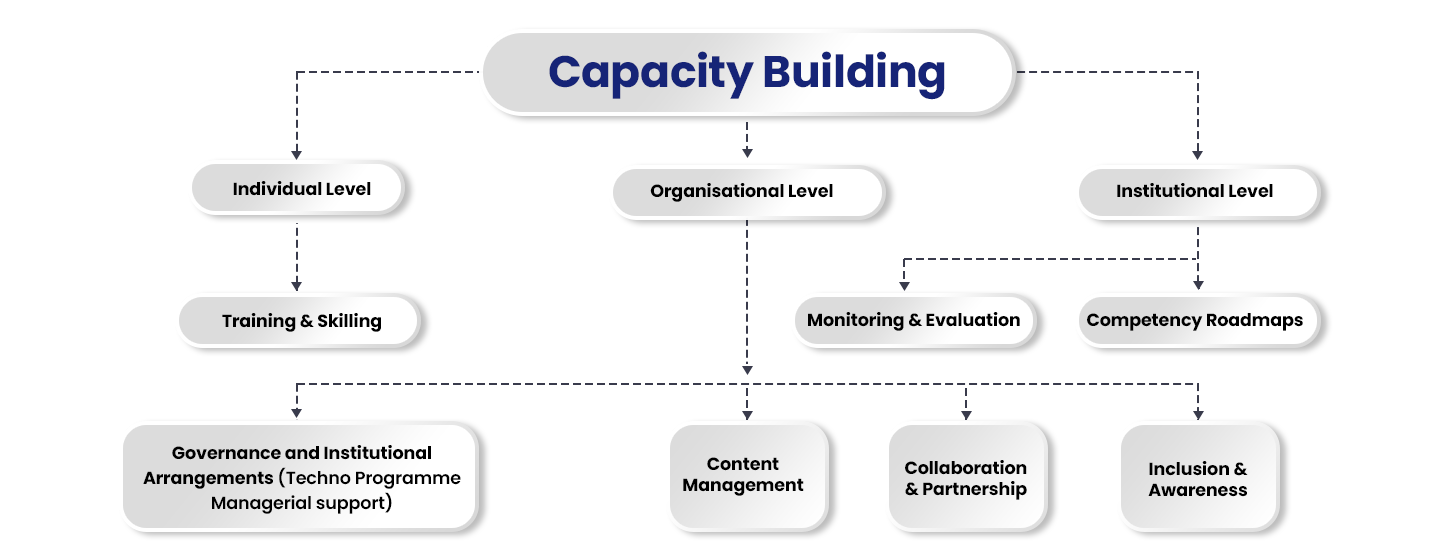Capacity Building

Vision and Objectives of Phase III
The Capacity Building Scheme (CB) Phase III is a strategic initiative under the Digital India programme that envisions building adequate and relevant capacities at all government levels. This phase builds on the successes and lessons learned from Phase I and Phase II, expanding its reach and incorporating advanced learning methodologies to meet the evolving needs of governance in the digital age.
Phase III strongly emphasises specialized training programs designed to address the capacity-related challenges within the government. These programs cover various topics, including Digital Governance projects, emerging technologies, and role-based training for various government roles.
Vision: The Capacity Building Scheme Phase III envisions creating a digitally competent government workforce that can efficiently drive and manage digital governance initiatives across India, contributing to the broader goals of Digital India and sustainable development.

Objectives:
- Enhance the capacities and competencies of government officials at various levels through targeted training programs.
- Leverage National learning platform such as i-Got, to provide continuous learning and knowledge sharing.
- Develop a pool of experts in emerging technologies to provide professional and technical expertise to support the policy-making bodies of the State / UTs, thereby strengthen digital transformation initiatives
- Foster collaboration and partnerships to exchange best practices and innovations in e-Governance.
- Promote inclusion and awareness to ensure widespread adoption and participation in digital governance.
Key Components of Phase III
Training and Capacity Development
Phase III strongly emphasises specialized training programs designed to address the capacity-related challenges within the government. These programs cover various topics, including Digital Governance projects, emerging technologies, and role-based training for various government roles. Key initiatives include:
- Specialized training in Digital Governance, Digital transformation and emerging technologies.
- Certification programs for project managers and IT professionals.
- Thematic workshops on new technology trends.
- Role-based programs for senior officials.
Collaboration and Partnerships
Phase III encourages collaboration with various stakeholders, including academic institutions, industry partners, and international organizations, to exchange knowledge and best practices in Digital Governance. Foster collaborative partnerships through practitioner forums, communities of practice, and cross-learning initiatives to enhance capacity building efforts.
State e-Mission Teams
State e-Mission Teams (SeMTs) play a pivotal role in the implementation and success of e-Governance initiatives across India. Established under the Capacity Building Scheme, SeMTs are composed of domain experts and IT professionals who provide critical support to State Governments and Union Territories in planning, executing, and managing Digital-Governance projects. These teams act as the backbone for digital transformation at the state level, ensuring that projects are aligned with national standards and local requirements. SeMTs facilitate the customization and adoption of Digital governance solutions, offer technical guidance, and build the capacity of state officials through targeted training programs. By bridging the gap between the central vision of Digital India and state-level execution, SeMTs help in creating a cohesive and integrated digital governance framework across the country. Their efforts have been instrumental in enhancing the efficiency, transparency, and accessibility of government services, ultimately contributing to the overall goal of a digitally empowered society.
Conformity Assessment Framework (CAF) for building digital competencies of Govt. officers
The Conformity Assessment Framework (CAF) for building digital competencies is being developed. By validating and enhancing the skills of government officials, the framework seeks to contribute to more efficient and innovative governance processes in the digital age. It aligns with the objectives of the Digital India Programme and other similar initiatives worldwide, aiming to bridge competency gaps and foster a digitally resilient workforce in the public sector. It will contribute to improved governance practices by Government officers.
CAF encompasses key competency domains essential for effective digital governance, including:

Importance and Relevance
The Capacity Building Scheme Phase III is crucial for several reasons:
- Digital Transformation: It supports the Digital India initiative by building a workforce capable of managing and implementing digital projects.
- Sustainable Development: By enhancing the capacity of government employees, the scheme contributes to achieving Sustainable Development Goals (SDGs) through improved governance and service delivery.
- Innovation and Efficiency: Training in emerging technologies fosters innovation and improves the efficiency of government operations.
- Inclusivity: The scheme promotes inclusivity by ensuring that all levels of government employees, including those in remote and undeserved areas, have access to training and development opportunities.
